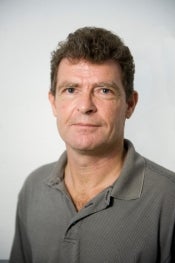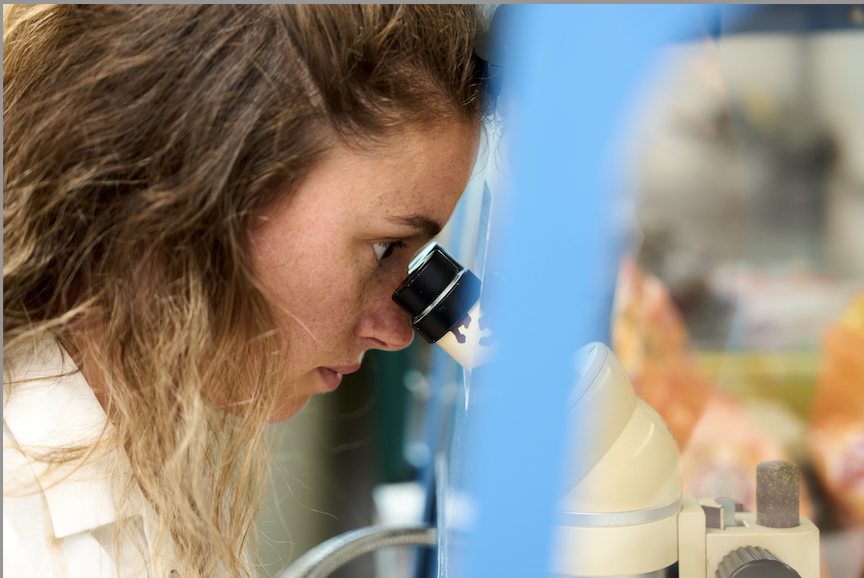40-year study charts oceans in peril

BATS research technicians Paul Lethaby and Claire Medley deploy the large-volume seawater pump in the Sargasso Sea. Photo courtesy Bermuda Institute of Ocean Sciences
Editor’s note: This story is featured in the 2023 year in review.
Recent years have seen dramatic global effects due to the Earth’s changing climate. In a new study, the result of 40 years of ocean research, scientists identify changes in the subtropical North Atlantic Ocean off the coast of Bermuda. The research has implications for oceans worldwide.
The paper, appearing in the current issue of the journal Frontiers in Marine Science, provides the longest sustained time series in the global ocean, tracking critical ocean trends over four decades.
Conducted from 1983 to 2023 at a pair of observation sites in the Sargasso Sea surrounding Bermuda, the comprehensive study shows a rise in surface ocean temperature of about 1 degree Celsius (1.80 F). The ocean acidity and salinity have also risen by 30% and 0.136 parts per thousand, respectively, according to the findings. Ocean acidity means a lowering of pH, similar to adding lemon juice to water, while the salinity measurement indicates a slight increase in the ocean’s salt content.
The findings also show that rising levels of atmospheric carbon dioxide from human activity have depleted Sargasso Sea surface waters of oxygen by 6%.
The compounding effects of these changes negatively affect diverse species, disrupting the food chain for primary oceanic organisms and higher organisms dependent on this energy source — from fish and marine mammals like whales, to seabirds and other life. Likewise, the impacts on human societies are expected to be far-reaching, from loss of fishing resources to inundation of coastal areas due to rising tides and less predictable precipitation patterns.
“The findings that present-day chemistry of Sargasso Sea surface waters is now completely different to 40 years ago illustrates the current and future challenges from global ocean change facing this large marine ecosystem of the North Atlantic,” said Nicholas Bates, principal investigator of the study.
Bates, a chemical oceanographer, is director of research with the Bermuda Institute of Ocean Sciences at Arizona State University. He is also a senior global futures scientist with ASU’s Julie Ann Wrigley Global Futures Laboratory and a professor in the ASU School of Ocean Futures.
“The information about changes in our oceans gathered from this long-term study is invaluable and can only be gained through ship-based observations that are sustained over many decades,” said Peter Schlosser, vice president and vice provost of Global Futures and director of the Global Futures Laboratory. “The observed trends in ocean temperature, salinity and carbon chemistry confirm that our oceans are undergoing a dramatic change due to human-caused global warming.
"They emphasize the urgency of taking immediate action to limit this warming to as close to 1.5 Celsius as possible through immediate, deep cuts in greenhouse gas emissions and extraction of carbon dioxide from the atmosphere.”
One of the most dramatic findings of the new study is that the ocean chemistry of surface waters now falls outside of the seasonal range observed in the 1980s. Such changes threaten the health of the foundation of the ocean food chain, consisting of tiny organisms known as phytoplankton.
“The ocean ecosystem, including calcifying phytoplankton, now lives in a different chemical environment to that experienced a few decades ago,” Bates said. “The changes in the chemical environment and ocean acidification of the subtropical North Atlantic Ocean is due to the uptake of anthropogenic carbon dioxide from the atmosphere.”
Phytoplankton, microscopic plant-like organisms drifting in the ocean, are foundational to marine ecosystems. They belong to a diverse group of photosynthetic microorganisms that inhabit the upper sunlit layer of almost all oceans and bodies of freshwater. Like terrestrial plants, they perform photosynthesis, converting sunlight and carbon dioxide into oxygen and biomass, thereby producing about half of the world's oxygen.
This process forms the bedrock of marine food webs, as phytoplankton are primary producers, feeding a vast array of marine life — from tiny zooplankton to whales.
Climate change poses significant threats to these vital organisms. Rising sea temperatures and acidification affect phytoplankton's ability to calcify, a process crucial for certain species like coccolithophores. This change in calcification impacts not just the phytoplankton but the entire oceanic carbon cycle.
Warmer waters can also alter phytoplankton distribution and blooming patterns, potentially disrupting marine food chains and biodiversity. As phytoplankton dynamics shift, the entire marine ecosystem — including fish populations and overall ocean health — faces significant challenges.
Taking the ocean’s pulse
The study is one of the few undertakings of its kind, tracking multi-decade changes of the Earth’s ocean systems. It provides a treasure trove of data of vital importance for both scientists and policymakers grappling with the worsening effects of climate change.
The project to better understand the physics, biogeochemistry and ocean acidification of the subtropical North Atlantic Ocean began in 1954, with the creation of Hydrostation S. This monitoring station is situated about 25 km to the southeast of Bermuda. Established by Henry Stommel, a pioneering ocean scientist from Woods Hole Oceanographic Institution, Hydrostation S has gathered vital information about ocean dynamics, from physical variables like temperature and salinity to biological measurements of phytoplankton over time.
Today, Bates and co-principal investigator Rod Johnson continue this work at a second ocean measurement station known as BATS (for Bermuda Atlantic Time-series Study), established in 1983. Both time series have been funded by the U.S. National Science Foundation, with BATS funded until 2028.
At the BATS monitoring station, ocean surface temperatures have increased by around 0.24 C each decade since the 1980s. Added up, the ocean is around 1 C warmer now than it was 40 years ago. In the last four years, ocean temperatures have also risen more sharply than in the previous decades, the researchers found.
Location is everything
The Bermuda monitoring stations provide researchers with an exceptional opportunity to take snapshots of ocean health, with global significance.
“We now have a window to observe what's going on in the surface ocean, but also in the deep ocean,” Bates said. “So, for example, waters from the Labrador Sea flow past Bermuda. There are water masses that are formed in Greenland, Iceland and the Norwegian Sea, which contribute to global ocean circulation and climate. Those waters pass Bermuda. And in the Southern Ocean, around Antarctica, there's a water mass called Antarctic bottom water, which flows northward past Bermuda.”
Significant alterations in the Arctic Ocean, which include a substantial loss of summertime sea ice, are leading to fresher, less-saline water. This decrease in sea ice results in less sunlight being reflected back into the atmosphere, contributing to a greener Arctic.
These changes, which have been detected in the two time-series ocean measurements in the Sargasso Sea, have sweeping implications: They affect the global climate system and have a direct impact on Indigenous communities in the Arctic, requiring adjustments in fishing practices and altering whale migration routes.
Such findings heighten the importance of the ASU BIOS project. The ocean monitoring stations in the Sargasso Sea are vital for keeping continuous tabs on ocean health, providing invaluable assessments and data for policymakers grappling with the mounting effects of climate change.
The Bermuda monitoring stations are now part of a wider array of locations gathering long-term data on the world’s oceans that are critical to our understanding of the trends caused by human activities. Stations off Hawaii, the Canary Islands, Iceland and New Zealand are also key to monitoring long-term oceanic changes.
More Environment and sustainability

A 6-month road repair that only takes 10 days, at a fraction of the cost? It's possible thanks to ASU concrete research
While Arizona’s infrastructure may be younger than its East Coast counterparts, the effects of aging in a desert climate have begun to take a toll on its roads, bridges and railways. Repairs and…

Mapping DNA of over 1 million species could lead to new medicines, other solutions to human problems
Valuable secrets await discovery in the DNA of Earth’s millions of species, most of them only sketchily understood. Waiting to be revealed in the diversity of life’s genetic material are targets for…

From road coatings to a sweating manikin, these ASU research projects are helping Arizonans keep their cool
The heat isn’t going away. And neither are sprawling desert cities like the metro Phoenix area.With new summer records being set nearly every year — 2024 was the warmest year on record for…




